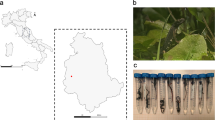Abstract
Electrophoretic studies were carried out on isozymes of Glossina pallidipes to determine whether there are any genetic differences between natural populations from an area free of sleeping sickness (Nguruman) and an area where sleeping sickness is endemic (Lambwe Valley) in Kenya. Out of 12 enzymes examined, two enzymes, GPI and PGM, showed high polymorphism in the two populations, while the other 10 enzymes were all monomorphic. At the GPI locus, at least five alleles were detected, and two alleles were found at the PGM locus. There was a difference in the frequency of isozyme patterns between males and females, indicating that the PGM locus is on the sex-linked chromosome (X-chromosome). Nei’s genetic distance (D) was 0.00154 between the two populations, which is the value within the range for local populations in different organisms examined so far. Some difference between the two populations was found in the level of average heterozygosity (H) and in allelic composition of the GPI locus, that is, the Lambwe Valley population is more heterogeneous than the Nguruman population.
Résumé
Plusieurs isozyme de Glossina pallidipes ont èté analysés par électrophorèse pour savoir si des différences génétiques existaient entre les populations d’une région non-endémique (Nguruman) et celles d’une région endèmique (Lambwe Valley). La trypanosomiase humaine est prèsente dans cette région du Kenya. Des 12 enzymes analysés, 2 sont polymorphiques (GPI et PGM) alors que les 10 autres sont monomorphiques. Pour le locus GPI, 5 alleles au moins sont dètectés alors que 2 allèles sont prèsents dans le locus PGM. Une différence dans la fréquence du schéma d’isozyme est trouvée entre maies et femalles indiquant que le locus PGM est lié au chromosome sexuel (chromosome X). Les distances génétiques de Nei (D) sont de 0.00154 entre les populations des régions non-endèmiques et endèmiques. Elles correspondent à la valeur trouvée à l’intèrieuve des populations locales pour lest différents organismes ètudiés jusqui à présent. Quelques différences entre les deux populations ont èté trouvèes pour la moyenne d’hétèrozygotie (H) et dans la composition allèlique du locus GPI. La population de Lambwe Valley est plus hètérozygote que celle de Nguruman.
Similar content being viewed by others
References
Bullini L. and Coluzzi M. (1978) Applied and theoretical significance of electrophoretic studies in mosquitoes. (Diptera: Culicidae). Parasitologia 20, 7–21.
Gooding R. H. (1984) Tsetse genetics: Review. Quest. Ent. 20, 89–128.
Gooding R. H. and Rolseth B. M. (1978) Genetics of Glossina morsitans morsitans (Diptera: Glossinidae). II. Electrophoretic banding patterns of midgut alkaline phosphatase. Can. Ent. 110, 1241–1246.
Nei M. (1972) Genetic distance between populations. Am. Nat. 106, 283–292.
Nei M. (1975) Molecular Population Genetics and Evolution. North-Holland, Oxford.
Rolseth B. M. and Gooding R. H. (1978) Genetics of Glossina morsitans morsitans (Diptera: Glossinidae). I. Electrophoretic banding patterns in xanthine oxidase and aldehyde oxidase. Can. Ent. 110, 1233–1239.
Selander R. K., Smith M. H., Yang S. Y., Johnson W. E. and Centry J. B. (1971) Biochemical polymorphism and systematics in the genus Peromyscus. I. Variation in the old-field mouse (Peromyscus polionotus). Studies in Genetics 6 (Univ. Texas Publ. 7103), p. 49–90.
Shaw C. R. and Prasad R. (1970) Starch gel electrophoresis of enzymes—A compilation of recipes. Biochem. Genet. 4, 297–320.
Smith I. (1968) Starch gel electrophoresis. In Chromatographic and Electrophoretic Techniques (Edited by Smith I.),pp. 217–324. Heineman Medical Book Ltd., New York.
Taylor A. E. R. and Muller R. (1979) Problems in the Identification of Parasites and Their Vectors. Blackwell Scientific Publication, Oxford.
Townsen H. (1976) Enzyme polymorphisms in vectors of disease—its study and interpretation of results: Studies of enzymes in the Simulium damnosum complex and Aedes scutellaris group.. WHO Publ. VBC/SC/76, p. 21.
Van Etten J. (1982) Enzyme polymorphism in populations of the tsetse fly Glossina pallidipes in. Kenya. Ent. Exp. Appl. 31, 197–201.
Van der Geest L. P. S., Cornelissen A., Tjon-A-Joe H. P. and Helle W. (1978) A study on isoenzyme polymorphism in the tsetse fly Glossina morsitans. Ent. Exp. Appl. 23, 269–278.
Van der Geest L. P. S. and Kawooya J. (1975) Genetic variation in some enzyme systems in the tsetse fly Glossina morsitans. Ent. Exp. Appl. 18, 508–514.
Author information
Authors and Affiliations
Rights and permissions
About this article
Cite this article
Agatsuma, T., Otieno, L.H. Isoenzyme Studies on two Field Populations of Glossina pallidipes Austen (Diptera, Glossinidae) in Kenya. Int J Trop Insect Sci 9, 527–530 (1988). https://doi.org/10.1017/S1742758400011085
Received:
Published:
Issue Date:
DOI: https://doi.org/10.1017/S1742758400011085




